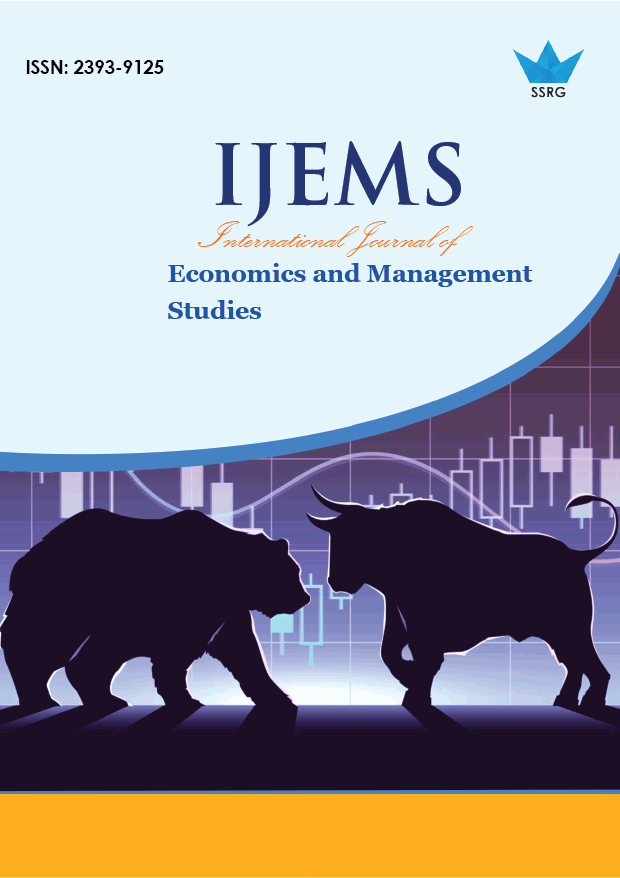Research on the Market Competition Effect of Corporate Cash Holding: A Case Study of ANTA

| International Journal of Economics and Management Studies |
| © 2025 by SSRG - IJEMS Journal |
| Volume 12 Issue 4 |
| Year of Publication : 2025 |
| Authors : Bingbin Dai, YiXuan Wang, Yi Suo |
How to Cite?
Bingbin Dai, YiXuan Wang, Yi Suo, "Research on the Market Competition Effect of Corporate Cash Holding: A Case Study of ANTA," SSRG International Journal of Economics and Management Studies, vol. 12, no. 4, pp. 19-25, 2025. Crossref, https://doi.org/10.14445/23939125/IJEMS-V12I4P103
Abstract:
Under the dual context of the rapid development of the global sports industry and the rise of domestic brands, China's sports goods industry has encountered unprecedented market opportunities. However, upgrading consumption and intensifying competition have also placed higher demands on corporate strategic resilience. Particularly after the outbreak of the COVID 19 pandemic, supply chain disruptions and demand fluctuations have further amplified corporate cash flow risks, highlighting the strategic value of cash reserves. As the leader of domestic sports brands, Anta has achieved countercyclical growth during the pandemic by holding excess cash and surpassing international brands in market share. Its case provides a typical sample for exploring the competitive effects of cash holdings. This study employs a combination of case analysis and comparative analysis, focusing on Anta's financial data and market performance and its domestic competitors (Li-Ning, Xtep, and 361 Degrees) from 2016 to 2023. By systematically organizing Anta's cash holding scale, structure, and dynamic changes through databases and company annual reports and constructing multidimensional indicators to analyze the mechanisms of its competitive effects, this research enriches the "cash is king" theory, expands the application of cash holding competitive effect theory in the sports goods industry, and fills the gap in the research of this theory in China's emerging markets. Especially in the context of the pandemic shock, it reveals the unique mechanism by which cash reserves drive market share concentration towards leading enterprises in a crisis.
Keywords:
Excess cash holdings, Competitive effects, ANTA Corporation, Sports industry.
References:
[1] Azizjon Alimov, “Product Market Competition and the Value of Corporate Cash: Evidence from Trade Liberalization,” Journal of Corporate Finance, vol. 25, pp. 122-139, 2014.
[CrossRef] [Google Scholar] [Publisher Link]
[2] Ozgur Arslan, Chrisostomos Florackis, and Aydin Ozkan, “The Role of Cash Holdings in Reducing Investment-Cash Flow Sensitivity: Evidence from a Financial Crisis Period in an Emerging Market,” Emerging Markets Review, vol. 7, no. 4, pp. 320-338, 2006.
[CrossRef] [Google Scholar] [Publisher Link]
[3] Thomas W. Bates, Kathleen M. Kahle, and Rene M. Stulz, “Why Do U.S. Firms Hold So Much More Cash than They Used to?,” Journal of Finance, vol. 64, no. 5, pp. 1985-2021, 2009.
[CrossRef] [Google Scholar] [Publisher Link]
[4] Jean-Pierre Benoit, “Financially Constrained Entry in a Game with Incomplete Information,” Rand Journal of Economics, vol. 15, no. 4, pp. 490-499, 1984.
[CrossRef] [Google Scholar] [Publisher Link]
[5] Patrick Bolton, and David S. Scharfstein, “A Theory of Predation Based on Agency Problems in Financial Contracting,” American Economic Review, vol. 80, no. 1, pp. 93-106, 1990.
[Google Scholar] [Publisher Link]
[6] Murillo Campello, “Capital Structure and Product Markets Interactions: Evidence from Business Cycles,” Journal of Financial Economics, vol. 68, no. 3, pp. 353-378, 2003.
[CrossRef] [Google Scholar] [Publisher Link]
[7] Murillo Campello, John R. Graham, and Campbell R. Harvey, “The Real Effects of Financial Constraints: Evidence from a Financial Crisis,” Journal of Financial Economics, vol. 97, no. 3, pp. 470-487, 2010.
[CrossRef] [Google Scholar] [Publisher Link]
[8] Chong-Chuo Chang, and Han Yang, “The Role of Cash Holdings During Financial Crises,” Pacific-Basin Finance Journal, vol. 72, 2022.
[CrossRef] [Google Scholar] [Publisher Link]
[9] Ran Duchin, Oguzhan Ozbas, and Berk A. Sensoy, “Costly External Finance, Corporate Investment, and the Subprime Mortgage Credit Crisis,” Journal of Finance, vol. 97, no. 3, pp. 418-435, 2010.
[CrossRef] [Google Scholar] [Publisher Link]
[10] Laurent Fresard, “Financial Strength and Product Market Behaviors: The Real Effects of Corporate Cash Holdings,” Journal of Finance, vol. 65, no. 3, pp. 1097-1122, 2010.
[CrossRef] [Google Scholar] [Publisher Link]
[11] David Haushalter, Sandy Klasa, and Williams F. Maxwell, “The Influence of Product Market Dynamics on a Firm's Cash Holdings and Hedging Behavior,” Journal of Financial Economics, vol. 84, no. 3, pp. 797-825, 2007.
[CrossRef] [Google Scholar] [Publisher Link]
[12] Jarrad Harford, Wayne Mikkelson, and M. Megan Partch, “The Effect of Cash Reserves on Corporate Investment and Performance in Industry Downturns,” Working Paper, pp. 1-28, 2003.
[Google Scholar] [Publisher Link]
[13] Didem Kurt, and John Hull, “Aggressive Marketing Strategy Following Equity Offerings and Firm Value: The Role of Relative Strategic Flexibility,” Journal of Marketing, vol. 77, no. 5, pp. 57-74, 2013.
[CrossRef] [Google Scholar] [Publisher Link]
[14] Evgeny Lyandres, and Berardino Palazzo, “Cash Holdings, Competition, and Innovation,” Journal of Financial and Quantitative Analysis, vol. 51, no. 6, pp. 1823-1861, 2016.
[CrossRef] [Google Scholar] [Publisher Link]
[15] Bernadette A. Minton, and Catherine Schrand, “The Impact of Cash Flow Volatility on Discretionary Investment and the Costs of Debt and Equity Financing,” Journal of Financial Economics, vol. 54, no. 3, pp. 423-460, 1999.
[CrossRef] [Google Scholar] [Publisher Link]
[16] Tim Opler et al., “The Determinants and Implications of Corporate Cash Holdings,” Journal of Financial Economics, vol. 52, no. 1, pp. 3 46, 1999.
[CrossRef] [Google Scholar] [Publisher Link]
[17] Tim C. Opler, and Sheridan Titman, “Financial Distress and Corporate Performance,” Journal of Finance, vol. 49, no. 3, pp. 1015-1040, 1994.
[CrossRef] [Google Scholar] [Publisher Link]
[18] Enrique Schroth, and Dezso Szalay, “Cash Breeds Success: The Role of Financing Constraints in Patent Races,” Review of Finance, vol. 14, no. 1, pp. 73-118, 2010.
[CrossRef] [Google Scholar] [Publisher Link]
[19] L.G. Telser, “Cutthroat Competition and the Long Purse,” Journal of Law and Economics, vol. 9, 1966.
[CrossRef] [Google Scholar] [Publisher Link]
[20] Michael Zheng, “Is Cash the Panacea of the COVID-19 Pandemic: Evidence from Corporate Performance,” Finance Research Letters, vol. 45, 2022.
[CrossRef] [Google Scholar] [Publisher Link]

 10.14445/23939125/IJEMS-V12I4P103
10.14445/23939125/IJEMS-V12I4P103